8 min read
The Get Home Bag
Many of you have a survival kit or bug out bag in your home but do you have a Get Home Bag? A "get home bag" (also known as a "go bag" or...
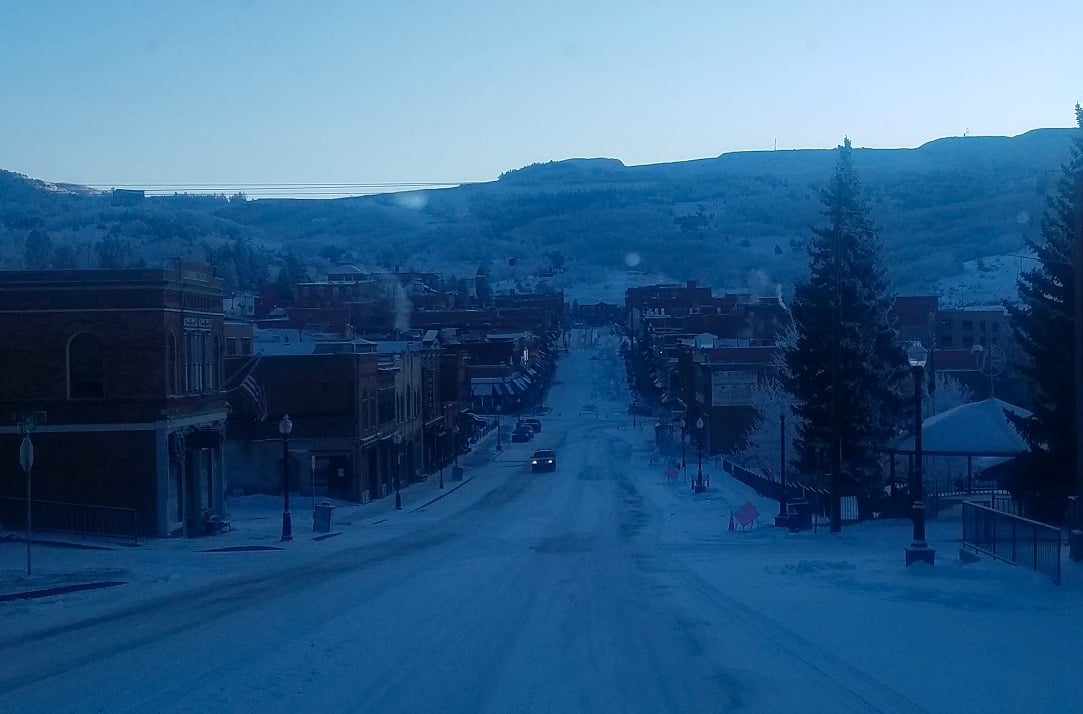
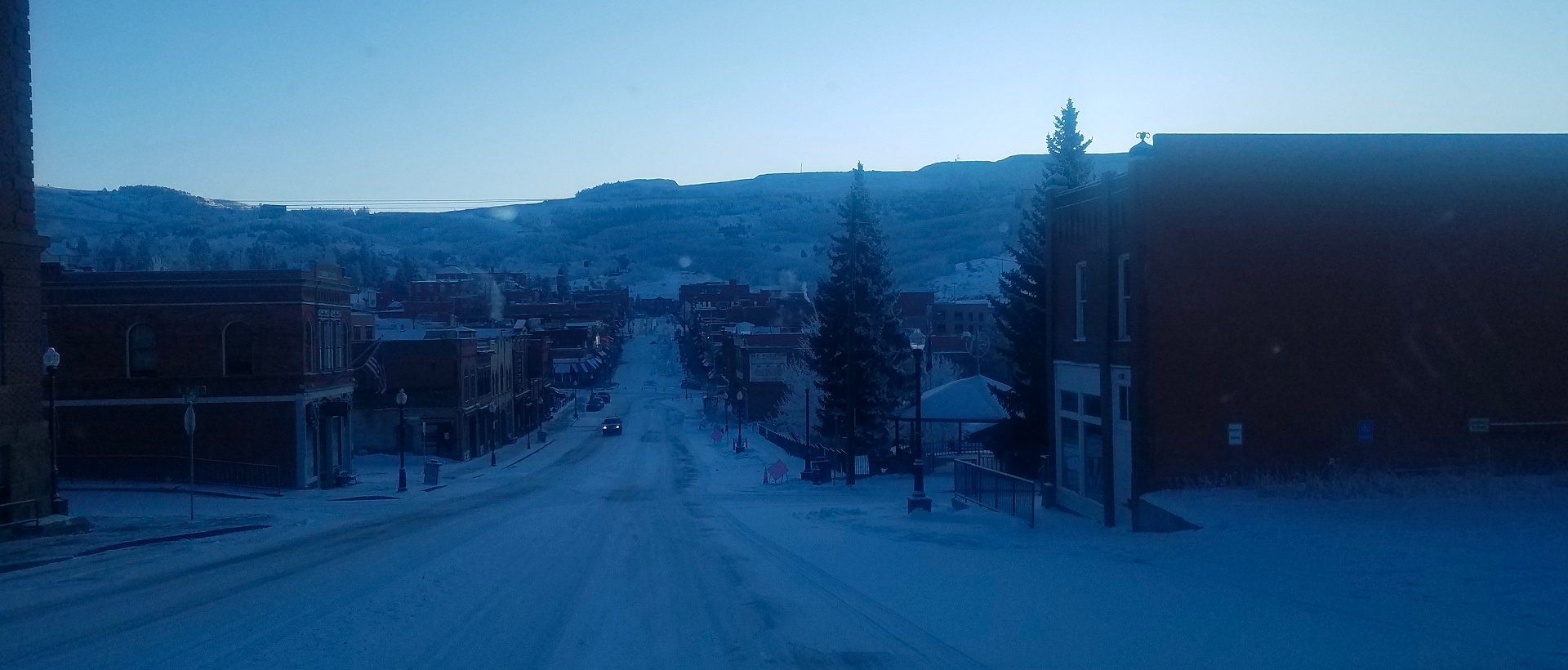
Alright folks, it's time to talk about winter vehicle preparedness and your winter car emergency kit, although the preparedness mindset should be applied to driving in any kind of weather. If you haven't heard, there were quite a few people stranded in their vehicles for more than 24 hours on I-95 in Virginia on January 4th back in 2022.
This debacle wasn't an isolated incident, and it seems to happen somewhere every year. As I read more news stories on this, some things that people said in the interviews began to stand out to me. In case you're not familiar with it, at The Survival University we teach “The Rule of Threes”. Simply put, as a general rule a human can last about three minutes without oxygen (including blood flow) to the brain, three hours exposed to extreme heat or cold, three days without water, and three weeks without food. We also like to add in 'three seconds without hope', because your mental attitude in the face of adversity is by far your most important survival tool. Now with this Rule of Threes in mind, we will take a look at six articles I read (see below) and see where the “average person's” priorities are.
Altogether, these six articles mentioned food, hunger, eating, and snacks 17 times, 23 times including the general term “supplies”! As I stated above, in a survival situation, food is often the least important concern. Now that's not to say that going without food is easy or fun, and for people with certain medical conditions food may indeed be more important than some of the other rules. I myself suffer from mild hypoglycemia. So even though food is at the bottom of the survival basics, you should always have some in your vehicle just to be safe. If you think about it, each reference to food in these news articles was about people who didn't even bother to carry the “least important” supply. Personally I always carry a few hard candies in case I have an issue with my own blood sugar, I carry a small tube of plain cake frosting in my medical kit in case I have to render aid to someone in diabetic shock, and I carry a few granola bars for something a little more substantial to tide me over. A last note on food since I'll be discussing water next; if you are in a situation where you have food but don't have water and are at risk of dehydration, you should actually not eat the food. The reason for this is that your digestive system needs water to help break things down, and will pull water from the rest of your body to do so, thereby accelerating the dehydration process.
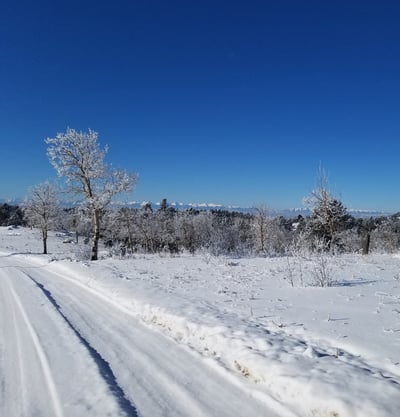 That's right folks, I'm talking about regular old water, and the problems that arise when you don't have it. What is it exactly that caused all of these drivers to end up in this unpleasant situation? Ding ding ding! All of these drivers were surrounded by water, but I found no references to anyone actually harvesting snow or ice to drink. As you may be aware, eating ice or snow to stay hydrated if you don't have a way to keep warm is a very bad idea. You should always melt the snow or ice first, so that your body doesn't have to burn more calories to keep your core body temperature up. In all six articles, I found references to thirst, water, and drink 17 times, 20 times if you also count the word “supplies”. You should always keep a bottle or two of water (per person) minimum in your vehicle, especially if you're living or traveling in an arid area. I also carry a small water filter such as a Sawyer Mini or Sawyer Squeeze in case I need to purify water without boiling it. A note on filters though; if you use them in the winter time and allow them to freeze with moisture inside, you will destroy the filter. Most filters use a system of microscopic straws to allow water through, but no cysts or bacteria. Since water expands when it freezes, it can rupture and destroy these straws, allowing contamination through. So if you're using a filter in the winter, simply keep the filter next to your body where it's warm at all times. Additionally, having a single walled NON INSULATED metal water bottle is always a good idea. Insulated bottles will make heating anything inside very difficult, will not efficiently conduct heat or cold from the contents, and may even explode or fail if heated over flames. I myself prefer a larger 64oz wide mouth single wall 'Klean Kanteen' or equivalent. Obviously it's a water bottle, but with this simple item I can also purify tainted water by boiling it, I can melt snow or ice in it, make a soup or prepare other foodstuffs, and I can use it as a warming device by filling it with hot water and then putting it in the foot of my sleeping bag or a part of my body that has arteries to warm the blood as it flows by. Now you'll notice that a fair few of these uses require heat or flame. I'll cover that in the next section, which is Shelter.
That's right folks, I'm talking about regular old water, and the problems that arise when you don't have it. What is it exactly that caused all of these drivers to end up in this unpleasant situation? Ding ding ding! All of these drivers were surrounded by water, but I found no references to anyone actually harvesting snow or ice to drink. As you may be aware, eating ice or snow to stay hydrated if you don't have a way to keep warm is a very bad idea. You should always melt the snow or ice first, so that your body doesn't have to burn more calories to keep your core body temperature up. In all six articles, I found references to thirst, water, and drink 17 times, 20 times if you also count the word “supplies”. You should always keep a bottle or two of water (per person) minimum in your vehicle, especially if you're living or traveling in an arid area. I also carry a small water filter such as a Sawyer Mini or Sawyer Squeeze in case I need to purify water without boiling it. A note on filters though; if you use them in the winter time and allow them to freeze with moisture inside, you will destroy the filter. Most filters use a system of microscopic straws to allow water through, but no cysts or bacteria. Since water expands when it freezes, it can rupture and destroy these straws, allowing contamination through. So if you're using a filter in the winter, simply keep the filter next to your body where it's warm at all times. Additionally, having a single walled NON INSULATED metal water bottle is always a good idea. Insulated bottles will make heating anything inside very difficult, will not efficiently conduct heat or cold from the contents, and may even explode or fail if heated over flames. I myself prefer a larger 64oz wide mouth single wall 'Klean Kanteen' or equivalent. Obviously it's a water bottle, but with this simple item I can also purify tainted water by boiling it, I can melt snow or ice in it, make a soup or prepare other foodstuffs, and I can use it as a warming device by filling it with hot water and then putting it in the foot of my sleeping bag or a part of my body that has arteries to warm the blood as it flows by. Now you'll notice that a fair few of these uses require heat or flame. I'll cover that in the next section, which is Shelter.
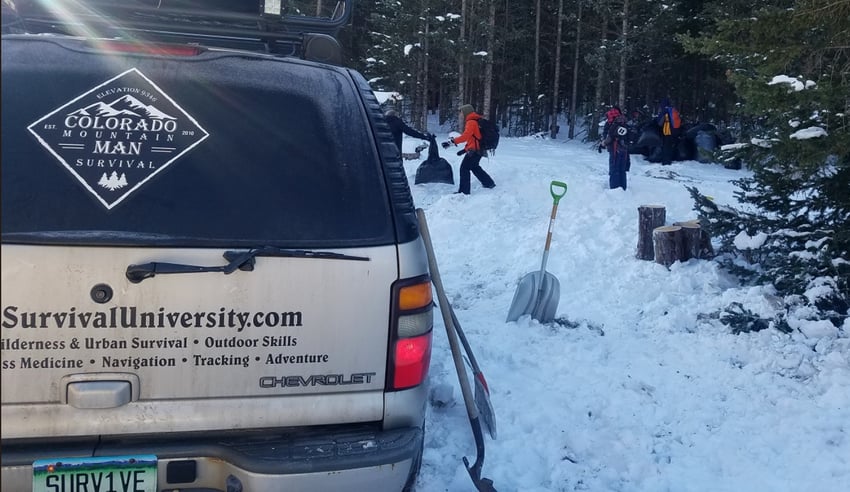
Without the invention of clothing that can create a layer of dead air for insulation, humans would never have been able to expand into parts of the globe that experience cold weather. Since shelter is all about temperature control, fire falls into this category as well. And since this article is all about vehicle preparedness, I'm going to consider mentions of gas/fuel or the lack thereof as references to shelter in the news articles. Altogether, gas and fuel were mentioned 25 times in these six articles. It would've been 26 or 27, but I didn't count the same person mentioning their own lack of fuel more than once. Now, I'm not saying you should stop at every single gas station on a trip, but I try to not ever let my vehicle get below a quarter tank, especially on trips in the winter. And when I drove a truck with a smaller tank, I always had a 5gallon NATO style Jerry Can of gas in the back. However, relying solely on your vehicle for warmth is still quite risky. There's usually a story every few years about someone who gets stuck or stranded somewhere, leaves their vehicle running overnight while they sleep in it, and then get asphyxiated because snow or something else ends up blocking their exhaust system. So in addition to keeping your tank reasonably topped up, you should always carry appropriate clothing, and in my opinion a sleeping bag or blanket as well. Relying on cotton in the wintertime is just asking for disaster, so my preference is wool or synthetics. I carry thick wool socks, polypro long johns, a wool sweater or shirt, a warm hat, and a fleece or down jacket. Something like your snow pants and jacket would be great, if you're into skiing or snowboarding. I don't yet have a sub-zero-rated sleeping bag, so I'll either bring along two 30ish-degree bags, or I'll bring an extra down puffy jacket that I can put down in the footbox of one of the sleeping bags. Additionally, I find air-activated hand warmers like 'hot hands' and other brands to be incredibly useful, so I always keep a few in my car kit as well. Open the pack, shake them up and let them activate, and then toss one or two down by your feet and in your pockets and you're set. That brings me to stoves or open flame to warm myself and melt snow or ice, and to cook a warm meal. Oftentimes I prefer to use a plain campfire, but in many cases this just isn't feasible, especially if you're not very good at starting fires. Some of the stoves I've tried and like are a small alcohol stove like an Esbit, an MSR Whisperlite Universal (can run on isobutane canisters, white gas, kerosene, and gasoline), a bio-fuel stove like an Emberlit or Firebox, or a JetBoil which are all solid choices (I own all of these stoves and find them sufficient, but I am not affiliated with or endorsed by them.) However, you should NEVER try and use these devices inside your vehicle. In addition to the asphyxiation risk I mentioned earlier, you're very likely to melt clothing, burn yourself, or even set your entire vehicle on fire. I myself set my truck bed on fire the first time I fired up a stove I wasn't familiar with. That was the last time I tried cooking in my vehicle!
 That brings us to 'blood flow' in the Rule of Threes system. What this usually equates to is medical care and first aid. Now thankfully, the articles I read said that there were no serious injuries. But a few did mention people not being able to take medications for fear of falling asleep. For those of you who have conditions that require medication, how much of this medication do you have with you in your vehicle, even for shorter trips? You should always carry enough medication with you for a few days in case of emergency, and this also applies to when you fly. You'd be surprised at how many people put their required medications in their checked bags, only to have the bag get delayed or lost somewhere (keep it in your hand carry or on your person if you can, instead). In addition to whatever medications you might need for yourself or your loved ones, you should always carry a decent first aid kit. We hate saying first aid kit because when this term is mentioned, most people envision the kit with 800 Band-Aids that you can buy at your department store. For the layman we will call it a first aid kit for now but what we mean is "medical kit". A proper self made medical kit is far more useful than the first aid kits you buy in a store. It is important that you have the training to USE said medical kit and everything that you put in it. An emergency situation is not when you want to be reading the instructions.
That brings us to 'blood flow' in the Rule of Threes system. What this usually equates to is medical care and first aid. Now thankfully, the articles I read said that there were no serious injuries. But a few did mention people not being able to take medications for fear of falling asleep. For those of you who have conditions that require medication, how much of this medication do you have with you in your vehicle, even for shorter trips? You should always carry enough medication with you for a few days in case of emergency, and this also applies to when you fly. You'd be surprised at how many people put their required medications in their checked bags, only to have the bag get delayed or lost somewhere (keep it in your hand carry or on your person if you can, instead). In addition to whatever medications you might need for yourself or your loved ones, you should always carry a decent first aid kit. We hate saying first aid kit because when this term is mentioned, most people envision the kit with 800 Band-Aids that you can buy at your department store. For the layman we will call it a first aid kit for now but what we mean is "medical kit". A proper self made medical kit is far more useful than the first aid kits you buy in a store. It is important that you have the training to USE said medical kit and everything that you put in it. An emergency situation is not when you want to be reading the instructions.
Alright, now this finally brings us to 'Three seconds without hope'. I'll also be combining this with what I believe is people's over-reliance on 'the system', and never thinking that anything bad can happen to them, or thinking that “it can't happen here”. I'll list a few quotes from the articles that really stood out to me. How different do you think they would have felt, if they'd just had a small car kit with some of the essentials in it? Without hope, you succumb to fear, and fear leads to panic and bad decisions. One small mistake can then snowball into a much more serious survival situation very quickly if you're not careful.
“No one came. It was just shocking,'” said Rao, who was traveling home to Burtonsville, Maryland, after visiting her daughter in North Carolina when she got stuck Monday evening. “'Being in the most advanced country in the world, no one knew how to even clear one lane for all of us to get out of that mess?”(1)
“'I’ve got three kids (and) we have been stuck since yesterday. Freezing nights and I have a baby on board. No food and no hope please help us letting the authorities know,' Paola Reynoso emailed WTOP.”(2)
“We need help, been out here for 18 hours and no help. This is ridiculous, please use your voice to get us help,' another wrote.”(2)
“I was not well-prepared; when I left Northern Virginia, it was 70 degrees...I’m surrounded by a bunch of 18-wheelers, it’s pitch-black, I’m freezing, I don’t have any snow boots I don’t really have a coat...There was no communication, there was no help, there was nobody on the ground. I would have thought there would have been volunteer firefighters….or policemen, nothing, not a soul.”(2)
“Vania Masaya was trapped in the gridlock with her young children and out of gas. Traffic came to a halt for them at about 9 a.m. Monday. Twelve hours later, they had barely moved, and the mother’s fear grew unbearable. 'I just kept thinking, they’re gonna die in this cold,' she said Tuesday, nearly crying. 'It was freezing. My daughter's cheeks were so cold.”(3)
“Some callers were sobbing and scared.”(4)
“Just after midnight, the street was packed like the flash mob in 'La La Land'...Though it was much grimmer, with people crying, smoking, walking their kids (and) pets, and begging for supplies."(5)
“You don't expect to be making calculations about, all right, do I have enough water to get me through before I get into a kind of trouble situation... Do I have enough gas in my car that's sitting idle on this highway? (Can it) stay running overnight and keep me warm?”(5)
“Lancaster said he tried calling VDOT himself, but he said he was left 'on hold' for two hours. Before that, he said he kept trying to reassure his sister and her partner that 'help will be here soon.' 'And it was like 4 a.m. when I suddenly realized help wasn't coming...I’m afraid to sleep, and afraid to stay up and see what happens...With the traffic jam starting during the snowstorm, the road below us was never (and has yet to be) salted...I’m from Florida, and have never driven on ice before...so really anxious about what’s next... I am genuinely terrified' Lancaster added.”(5)
“They passed out water (this morning). What is water going to do?...I ain’t ate in 24 hours, I ran out of gas, I called VDOT six times. No one came. This is an outrage. This is how you treat your taxpayers?”(6)
Yes indeed, even though we live in one of the most advanced societies in human history, things still can and do go wrong, as these people experienced firsthand. We live in such an advanced society that people were warned well in advance to not drive or travel unless absolutely necessary by forecasters, and yet they still did. They then chose to not be prepared, and instead want to blame everyone but themselves. If conditions are severe enough to strand you, why would you think that they're not severe enough to make it very difficult or impossible for road crews to clear, as well? In any situation, rescue crews will not respond if it endangers their lives as well, else they risk becoming a casualty themselves. They can only respond if the scene becomes safe enough. This applies to firefighters, medics, and search & rescue. It is not your right to demand someone else risk their life for yours, especially if it's because you chose to be unprepared. However, at least one person was able to cultivate the proper attitude: “'This has been a miserable experience, but at some point I kind of made the switch to a miserable travel experience to a survival project.'”
To finish off this article, I'd like to share with you a basic checklist for general vehicle safety, plus winter gear recommendations.
We highly recommend building your own car kit. There are many premade kits out there and most of these kits are subpar by our standard.
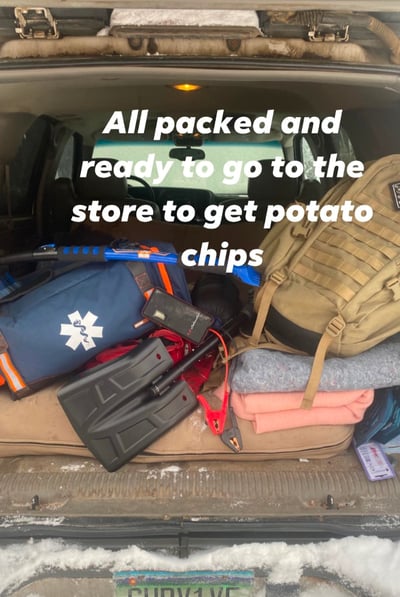 Consider building a survival kit, get home bag or bug out bag that you keep in your car at all times in case of any emergency.
Consider building a survival kit, get home bag or bug out bag that you keep in your car at all times in case of any emergency.
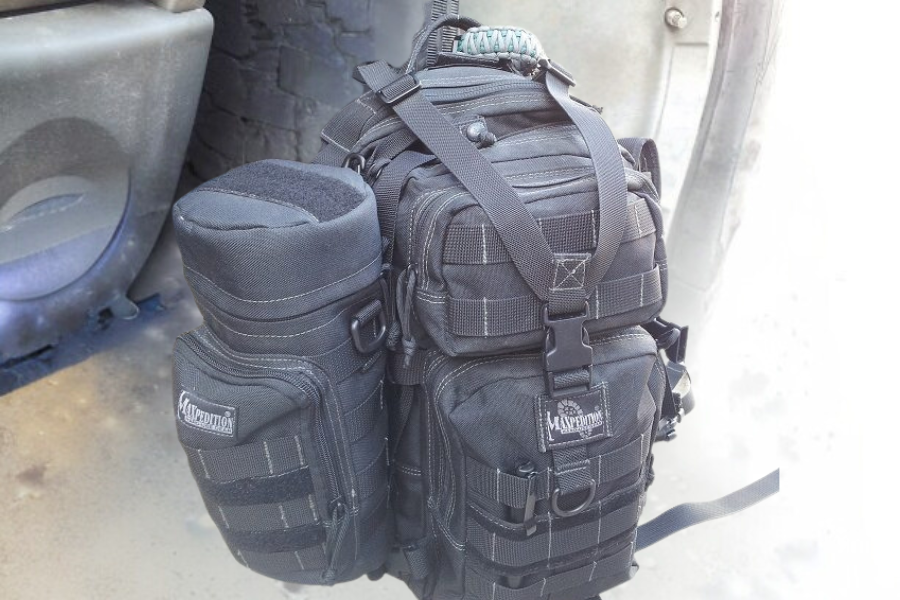
8 min read
Many of you have a survival kit or bug out bag in your home but do you have a Get Home Bag? A "get home bag" (also known as a "go bag" or...
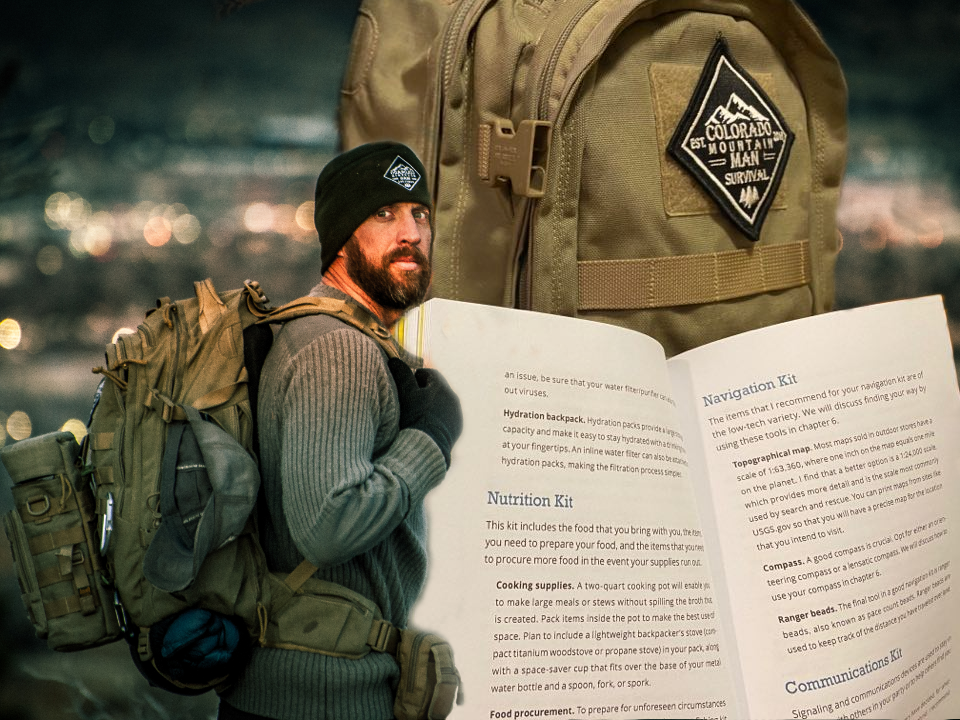
Analogy of a Survival Kit Survival kits are portable packages containing essential items and supplies that are designed to help individuals survive...
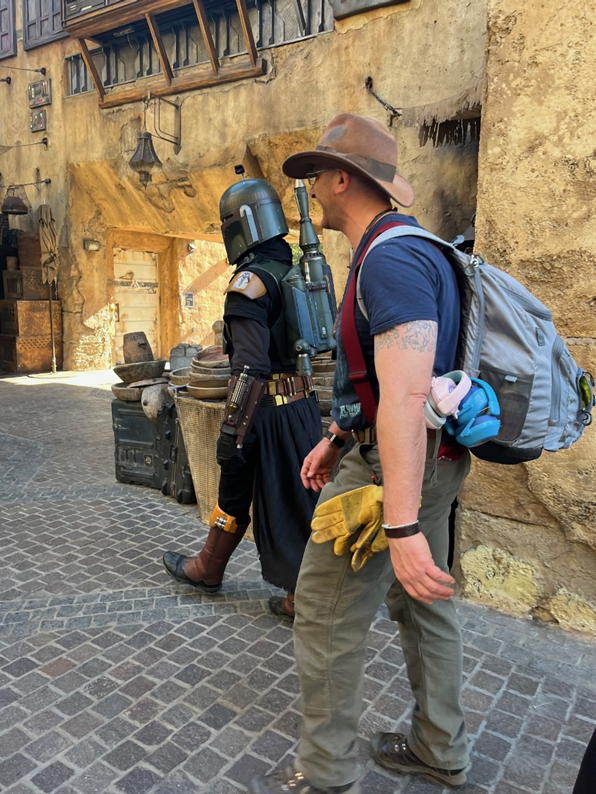
1 min read
Survival Tips: Preparing Your Bug Out Bag and Evacuation Plan for the 2025 LA Fires I was on my way to visit my oldest son in LA for a few days. As I...